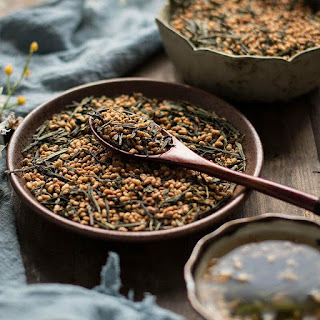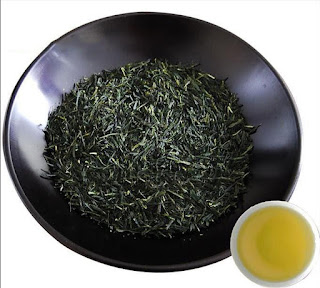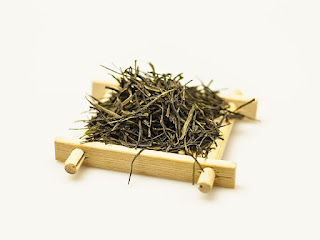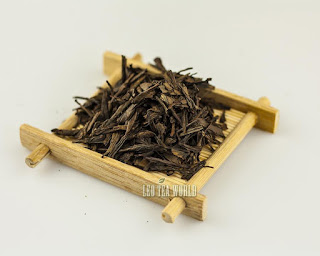Green tea has been used for centuries for their medical benefits and are even used today in modern science in alternative medicine. Green teas are not only healthy, but also incredibly flavorful and tasty. Some green teas boast earthy aromas and grassy favors which will peak your senses from the initial smell all the way down to the very last sip.
When people think of green tea, they often associate it with
the Japanese. In Japan, it is a staple beverage as it is available at almost
every restaurant across the region. It’s easy to stumble across some type of
food or beverage that has green tea within it. From matcha green tea lattes,
to ice cream, and even chocolate bars, green tea is everywhere in Japan!
Not to be confused a Chinese green tea, Japanese green teas
possess unique properties in both their roots and tastes that make the tea
drinking process even more exceptional. Let’s discover the many varieties that
Japanese green tea has to offer. We will find out what makes this tea so unique
and how to choose a tea that best fits your taste buds.
Japanese Green Tea’s History
Green tea actually originated in China, but found its way over to
Japan as it was carried back by nomadic Japanese monks. Japanese monks would
travel to China to learn about Buddhism. This is where the monks originally
discovered green tea. The irresistible green tea was then brought back by the
Buddhist monks to Japan, where the Japanese began to add their own special
twists to the brewing process. It’s thought that green tea was first introduced
to Japan during the Nara and Heian era, well over one thousand years ago.
Back then, only the upper class were able to get their hands on
green tea. As time went on, the production of the green tea leaf substantially
increased as farmers increased their yields. Thanks to the increased supply,
the demand was met and the popularity of green tea took off. Historians tell a
story of a priest in the 12th century called Myoan Eisai. Eisai
is credited for green tea demand increase when Eisai wrote a novel on how to
properly brew and drink green tea.
In the modern era, the Japanese have made green tea consumption a
part of everyday life. It is ingrained in their very culture. Green tea is even
used ceremoniously in traditional tea cups. When political figured arrive in
Japan, they are immediately offered green tea as a gesture of kindness and to
offer a warm welcome.
Types of Japanese Green Tea
Sencha
This is the most popular and widely drunk tea in all of Japan. Sencha
green tea is offered in most restaurants throughout the region. It’s
brewed by using the smallest tea leaves to give it its exceptional flavor and
aroma.
Sencha green tea is offered in many different forms, including a
high quality variety that is sure to tickle the fancy of even the most
dedicated green tea enthusiast. When harvested, the small leaves are
immediately steamed to avoid oxidation. After the leaves are protected, they
are packaged into cakes, balls, or spindles.
The taste walks a fine line between acidic and sweet. Sencha green
tea is considered to be mild in body and flavorful in taste. Many claim that
the green tea consists of hints of melon, pine, and grass. The premium Sencha
teas come with a more complicated taste that really calls out each flavor in a
bold flavor that is not too overwhelming.
The two different varieties of Sencha
green teas are distinguished by how the tea leaf is steamed. Asamushi
Sencha green tea is the way that the Japanese have been steaming green tea for
centuries. In this variation, the littlest green tea leaves are steamed for
around 60 seconds, giving it a soft yellow hue and particularly sweet in taste.
Fukmushi teas give Sencha green tea a modern twist which requires the leaf to
be steamed for a longer time. The longer steam time results in a darker color
with an unfiltered appearance. This tea offers a heavier and earthier flavor.
Gyokuro
Gyokuro
tea is another Japanese variation that is harvested from the Camellia sinensis plant. It is
unique in that the plant is grown in the shade in the final months before the
leaves are collected. The lack of sunlight during the last month of growth
inhibits the growth of cholorophyll and other antioxidants. This nutritious tea
has a soft and sweet flavor and is one of the healthiest Japanese green teas
available.
The lack of sunlight is also responsible for inhibiting the
production of L-theanine from morphing into a catechin. L-theanine is thought
to add to a consistent feed of caffeine, making it much less jittery and
helping with the dreaded caffeine crash.
Gyokuro tea is renowned for its creaminess and seaweed like
long-lasting flavor. This well-balanced green tea is soft and sweet through and
through.
Genmaicha
Genmaicha green
tea is unique in that the leaves are combined with brown rice kernels,
giving the tea a toasted and fuller taste. Genmaicha tea offers a filling
flavor similar to that of eating a bowl of chili. The brown rice removed rough
flavors from the green tea leaf, making it an easier beverage to enjoy.
Coined ‘the people’s tea’, Genmaicha tea was widely available and
incredibly popular as it was the cheapest green tea option available. The
combination of the cheap brown rice and the more expensive green tea leaves
made the overall cost very affordable for the general public.
In the modern era, Genmaicha green tea is renowned for its taste
and aroma that is unlike any other. It is also known to the people as ‘popcorn
tea’ thanks to the popped brown rice. Many Japanese use this tea as a palette
cleanser either both or after they eat. This tea is traditionally prepared at a
more elevated temperature than traditional green teas. The extra heat helps
unlock additional flavors of the brown rice kernels.
Matcha Green Tea
Matcha green tea is
well-known worldwide thanks to its stone-ground preparation. The ground leaves
leave behind a green powder that is renowned in the cooking world. The ground
powder is used to make popular drinks suck as the matcha latte. Once again,
this tea is cultivated in from plants that spend a portion of their life in the
shade.
The grinding process consists of the tea leaves being placed on
bamboo mats and first steamed and then dried. The dry leaves are the smashed
and obliterated to extract the popular green powder. The powder can also be extracted
in a mill.
Speaking of healthy teas, Matcha green tea is incredibly healthy.
Grinding the leaves allows you to ingest the entire leaf to get the most
nutrients as possible, rather on having to rely on extracting the nutrients
into a liquid. Matcha green tea has the incredibly high levels of L-theanine
amongst other nutrients.
This tea assists your digestive system in taking up Vitamin E and
other healthy fibers within the leaf itself. Saturated with antioxidants,
Matcha green tea is the healthiest Japanese green tea on this list.
For Macha brew guide, you can refer to HOW
TO PREPARE MATCHA GREEN TEA?
Hojicha
If you don’t like the jitters that are associated with a cup of
coffee or other stronger green teas, then you may enjoy Hojicha green tea.
This tea is infamous for its low caffeine content. It is uniquely roasted,
unlike the other steamed green tea varieties. The roasted leaves are pan-fried
after cultivated to keep oxidation at bay.
The roasted profile offers a nutty flavor and is also unique in
that it does not project a green hue like other green teas. The color is a
light brown hue thanks to the roasting process that the leaf undergoes.
Since the caffeine content is so low, many elderly whom are
concerned of heart conditions and even young children who are too young for a
cup of coffee drink this variety. It’s traditionally prepared for a short time
in hot water to avoid bitterness.
Kukicha
Kukicha green tea is truly special in that it is not brewed from
tea leaves at all. This tea is interestingly brewed from the stems and stalks
of the plant in hot water. Kukicha tea is also known as Bocha or stick tea
because of this.
Kukicha tea that only harvested from Sencha or Gyokuro plants is
referred to as Karigane tea. Karigane tea offers nutty flavors with a filling
creamy sensation. Kukicha is popularly consumed to aid the digestive system.
Guricha
Guricha tea is hard to come by and sought after by tea enthusiasts
everywhere. This uncommon tea variety makes up for about 5% of the entirety of
Japanese tea supply. Since it is so rare, Gruicha tea often sells for a very
high price at auction or at the market.
Coming from the Kyushu Island found within the Ureshino region,
Gruicha is known for its unique shape that closely resembles a comma. The color
of this tea when brewed is a dark pine with hints of sweetness. If you’re able
to get your hands on this, then you will understand why it is so sought after!
Uji Green Tea
Uji tea originates in Uji, Kyoto. It is a uniquely traditional tea
that is rooted deep within Japanese history. This ceremonial tea was
transported numerous times during the Meiji era. This tea would be presented to
the shogun of a military to show respect. It may not be the tastiest tea
available, but it still widely enjoyed by historians and those who appreciate
the culture.
How Do I Brew Japanese Green Tea?
This guide refer to general Japanese green tea include variants
introduced upon. To start, heat the water to temperature that ranges between
150 and 180 degrees Fahrenheit. Refer to the list below to make sure that you
are brewing your green tea variation at the correct temperature. We advise that
you refer to the product label for brewing instructions.
If the temperature is too high, then you may notice bitterness.
Boiling the water is not good for the flavor, so avoid this. Generally
speaking, follow the directions below to correctly brew different varieties of
Japanese green tea:
- Sencha: 140 to 158 degrees
Fahrenheit for one to one and a half minutes.
- Gyokuro: 122 to 140 degrees
Fahrenheit for one to two minutes.
- Matcha: 175 degrees Fahrenheit.
- Genmaicha: 185 degrees Fahrenheit
for one to two minutes.
- Hojicha: 200 degrees Fahrenheit from
anywhere from 30 seconds to three minutes.
- Kukicha: 185 degrees Fahrenheit for
up to one minute.
- Guricha: 158 to 176 degree
Fahrenheit for 35 to 45 seconds.
Drink Japanese Green Tea
When it comes to green tea, the Japanese are the best. The
seemingly endless amounts of variety will ensure that you discover a variety
that fits your palate. The cultural and traditional significance of green teas
in Asia make this beverage special. So pick a Japanese
green tea of your choice and be sure to enjoy it on us!






评论
发表评论